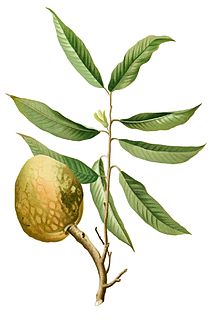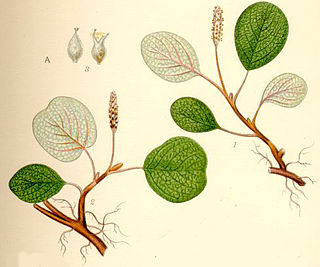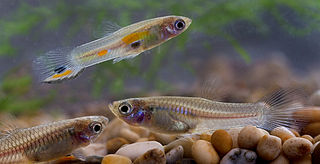
Geckos are small lizards belonging to the infraorder Gekkota, found in warm climates throughout the world. They range from 1.6 to 60 cm.

K-Meleon is an open-source web browser for Microsoft Windows. Originally based on the same Gecko layout engine as Mozilla Firefox and SeaMonkey, K-Meleon's design goal is to provide a fast and reliable web browser while providing a highly customizable interface and using system resources efficiently. Beginning with K-Meleon 76.2G, builds of the browser have utilized the Goanna layout engine instead of the Gecko engine. The browser is released under the GNU General Public License.

Gecko is a browser engine developed by Mozilla. It is used in the Firefox browser, the Thunderbird email client, and many other projects.

The substantia nigra (SN) is a basal ganglia structure located in the midbrain that plays an important role in reward and movement. Substantia nigra is Latin for "black substance", reflecting the fact that parts of the substantia nigra appear darker than neighboring areas due to high levels of neuromelanin in dopaminergic neurons. Parkinson's disease is characterized by the loss of dopaminergic neurons in the substantia nigra pars compacta.

Citrus is a genus of flowering trees and shrubs in the rue family, Rutaceae. Plants in the genus produce citrus fruits, including important crops such as oranges, lemons, grapefruits, pomelos, and limes. The genus Citrus is native to South Asia, East Asia, Southeast Asia, Melanesia, and Australia. Various citrus species have been utilized and domesticated by indigenous cultures in these areas since ancient times. From there its cultivation spread into Micronesia and Polynesia by the Austronesian expansion ; and to the Middle East and the Mediterranean via the incense trade route, and onwards to Europe.

The mandarin orange, also known as the mandarin or mandarine, is a small citrus tree fruit. Treated as a member of a distinct species of orange, it is usually eaten plain or in fruit salads. The tangerine is a group of orange-coloured citrus fruit consisting of hybrids of mandarin orange with some pomelo contribution.

Gekkonidae is the largest family of geckos, containing over 950 described species in 64 genera. Members of the Gekkonidae comprise many of the most widespread gecko species, including house geckos (Hemidactylus), tokay geckos (Gekko), day geckos (Phelsuma), mourning geckos (Lepidodactylus) and dtellas (Gehyra). Gekkonid geckos occur globally and are particularly species-rich in tropical areas.

The genus Eublepharis, of which one known type is The Leopard Gecko, were first described by the British zoologist John Edward Gray in 1827. The etymology of their name is 'eu' = good (=true) |'blephar' = eyelid, and all have fully functional eyelids. Members of this genus are found in eastern and southwestern Asia where they reside in rocky grassland habitats. These geckos are sturdily built. Their tail is shorter than their snout–vent length and their body is covered with numerous wart-like bumps. The toes do not have adhesive lamellae or membranes. Eublepharis are crepuscular or nocturnal ground-dwellers. Included in this group is the popular pet gecko: the leopard gecko. It is one of the top pet reptiles in the world, especially popular in the United States, where there are nearly 3 million captive bred leopard geckos. A common misconception about leopard geckos is that they live in dry, arid deserts, but they are from rocky grasslands in southwestern Asia, including northern India, Afghanistan and Pakistan. They avoid deserts and places with low water and prefer areas of low sunlight.

Oedura is a genus of medium to large geckos, lizards in the family Diplodactylidae. The genus is endemic to Australia. Species in the genus are referred to by the common name velvet geckos.

Annona reticulata is a small deciduous or semi-evergreen tree in the plant family Annonaceae and part of the Annonas group. It is best known for its fruit, called custard apple, a common name shared with fruits of several other species in the same genus: A. cherimola and A. squamosa. Its common names include wild sweetsop, soursop and bullock's heart. The fruit is sweet and useful in preparation of desserts, but is generally less popular for eating than that of A. cherimola.
The pars reticulata is a portion of the substantia nigra. Most of the neurons that project out of the pars reticulata are inhibitory GABAergic neurons.

Salix reticulata, the net-leaved willow, or snow willow, is a dwarf willow, native to the colder parts of Europe, North America, and Northern Asia. It is found in the western United States, including the Sierra Nevada and Rocky Mountains. In Europe it extends south through the Carpathian Mountains and Alps to the Pyrenees and the mountains of Bulgaria and North Macedonia. It is common in Canada, Greenland and Finland, and present but rare in Scotland.

The cam sành or King orange is a citrus hybrid originating in Vietnam.

Syringa reticulata, the Japanese tree lilac. is a species of flowering plant in the family Oleaceae native to eastern Asia, which is grown as an ornamental in Europe and North America.

The guppy, also known as millionfish and rainbow fish, is one of the world's most widely distributed tropical fish and one of the most popular freshwater aquarium fish species. It is a member of the family Poeciliidae and, like almost all American members of the family, is live-bearing. Guppies originate from northeast South America, but have been introduced to many environments and are now found all over the world. They are highly adaptable and thrive in many different environmental and ecological conditions. Male guppies, which are smaller than females, have ornamental caudal and dorsal fins. Wild guppies generally feed on a variety of food sources, including benthic algae and aquatic insect larvae. Guppies are used as a model organism in the fields of ecology, evolution, and behavioural studies.

The Diplodactylidae are a family in the suborder Gekkota (geckos), with about 137 species in 25 genera. These geckos occur in Australia, New Zealand, and New Caledonia. Three diplodactylid genera have recently been split into multiple new genera
Synaphea reticulata is a shrub endemic to Western Australia.

Amalosia is a genus of lizards in the family Diplodactylidae endemic to Australia. It includes four species: All species of this genus were previously included with the genus Oedura until 2012, when Oliver et al. transferred four species to this genus and erected two new monotypic genera, Hesperoedura for Oedura reticulata and Nebulifera for Oedura robusta Some taxonomic authorities still place all four species in the former genus. All species are native to Australia.
Velvet gecko can refer to any of the following gecko genera. Some genera are endemic to Australia, while others are endemic to Madagascar. :

Pygopodoidea is a gecko superfamily and the only taxon in the gekkotan subclade Pygopodomorpha. The clade includes three Australasian families: Diplodactylidae, Carphodactylidae, and Pygopodidae. Traditional gekkotan systematics had considered Diplodactylidae and Carphodactylidae as subfamilies of the family Gekkonidae, but recent molecular work have placed Pygopodidae within Gekkonidae making it paraphyletic. These analyses have shown support of Pygopodidae and Carphodactylidae being sister taxa, with Diplodactylidae occupying a basal position in Pygopodoidea.















